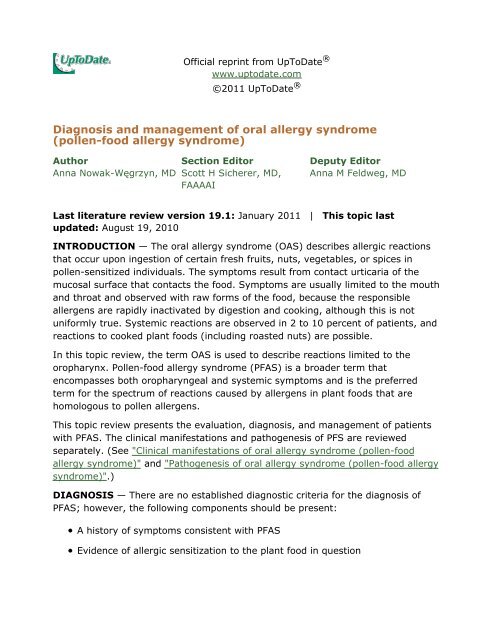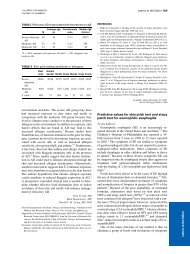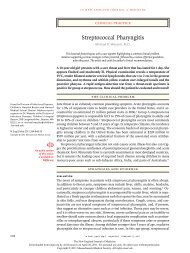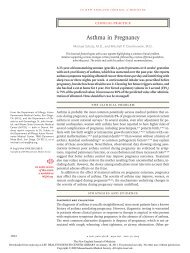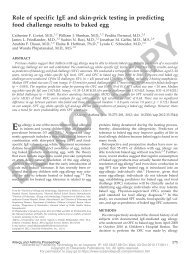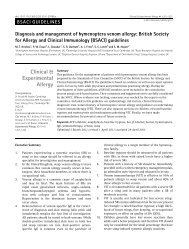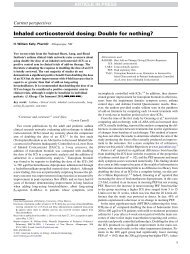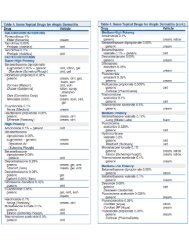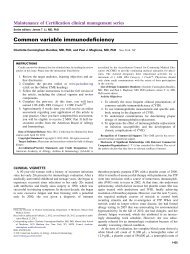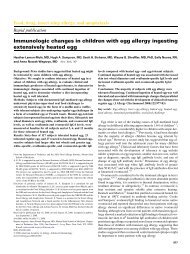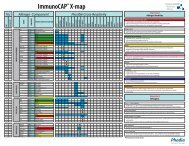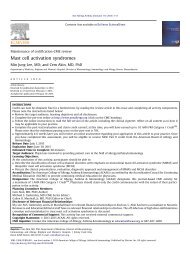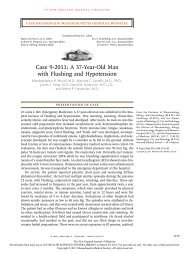Diagnosis and management of oral allergy syndrome ... - AInotes
Diagnosis and management of oral allergy syndrome ... - AInotes
Diagnosis and management of oral allergy syndrome ... - AInotes
Create successful ePaper yourself
Turn your PDF publications into a flip-book with our unique Google optimized e-Paper software.
Official reprint from UpToDate ®<br />
www.uptodate.com<br />
©2011 UpToDate ®<br />
<strong>Diagnosis</strong> <strong>and</strong> <strong>management</strong> <strong>of</strong> <strong>oral</strong> <strong>allergy</strong> <strong>syndrome</strong><br />
(pollen-food <strong>allergy</strong> <strong>syndrome</strong>)<br />
Author<br />
Anna Nowak-Węgrzyn, MD<br />
Section Editor<br />
Scott H Sicherer, MD,<br />
FAAAAI<br />
Deputy Editor<br />
Anna M Feldweg, MD<br />
Last literature review version 19.1: January 2011 | This topic last<br />
updated: August 19, 2010<br />
INTRODUCTION — The <strong>oral</strong> <strong>allergy</strong> <strong>syndrome</strong> (OAS) describes allergic reactions<br />
that occur upon ingestion <strong>of</strong> certain fresh fruits, nuts, vegetables, or spices in<br />
pollen-sensitized individuals. The symptoms result from contact urticaria <strong>of</strong> the<br />
mucosal surface that contacts the food. Symptoms are usually limited to the mouth<br />
<strong>and</strong> throat <strong>and</strong> observed with raw forms <strong>of</strong> the food, because the responsible<br />
allergens are rapidly inactivated by digestion <strong>and</strong> cooking, although this is not<br />
uniformly true. Systemic reactions are observed in 2 to 10 percent <strong>of</strong> patients, <strong>and</strong><br />
reactions to cooked plant foods (including roasted nuts) are possible.<br />
In this topic review, the term OAS is used to describe reactions limited to the<br />
oropharynx. Pollen-food <strong>allergy</strong> <strong>syndrome</strong> (PFAS) is a broader term that<br />
encompasses both oropharyngeal <strong>and</strong> systemic symptoms <strong>and</strong> is the preferred<br />
term for the spectrum <strong>of</strong> reactions caused by allergens in plant foods that are<br />
homologous to pollen allergens.<br />
This topic review presents the evaluation, diagnosis, <strong>and</strong> <strong>management</strong> <strong>of</strong> patients<br />
with PFAS. The clinical manifestations <strong>and</strong> pathogenesis <strong>of</strong> PFS are reviewed<br />
separately. (See "Clinical manifestations <strong>of</strong> <strong>oral</strong> <strong>allergy</strong> <strong>syndrome</strong> (pollen-food<br />
<strong>allergy</strong> <strong>syndrome</strong>)" <strong>and</strong> "Pathogenesis <strong>of</strong> <strong>oral</strong> <strong>allergy</strong> <strong>syndrome</strong> (pollen-food <strong>allergy</strong><br />
<strong>syndrome</strong>)".)<br />
DIAGNOSIS — There are no established diagnostic criteria for the diagnosis <strong>of</strong><br />
PFAS; however, the following components should be present:<br />
A history <strong>of</strong> symptoms consistent with PFAS<br />
Evidence <strong>of</strong> allergic sensitization to the plant food in question
Evidence <strong>of</strong> allergic sensitization to pollen<br />
A known correlation between the plant food(s) in question <strong>and</strong> a pollen(s) to<br />
which the patient is sensitized (figure 1)<br />
EVALUATION — As with any form <strong>of</strong> food <strong>allergy</strong>, the evaluation <strong>of</strong> PFAS combines<br />
a carefully gathered history, physical examination, objective testing for specific IgE<br />
to food <strong>and</strong>/or pollen, <strong>and</strong> possible <strong>oral</strong> food challenge [1]. All <strong>of</strong> these components<br />
are not necessary in each case, <strong>and</strong> the extent <strong>of</strong> the evaluation, as well as the<br />
approach to <strong>management</strong>, is influenced by the food to which the patient reacted<br />
<strong>and</strong> the severity <strong>of</strong> the symptoms.<br />
Most diagnostic <strong>allergy</strong> procedures, especially skin testing <strong>and</strong> food challenges,<br />
should be performed by <strong>allergy</strong> specialists with training in the <strong>management</strong> <strong>of</strong><br />
serious allergic reactions. In vitro tests for specific IgE may be performed by the<br />
non-specialist, although definitive interpretation may require a specialist's input.<br />
History — Important information obtained from the history includes the following:<br />
Has the patient experienced oropharyngeal symptoms, systemic symptoms, or<br />
both Patients with systemic symptoms should be thoroughly evaluated by an<br />
<strong>allergy</strong> specialist <strong>and</strong> provided with epinephrine autoinjectors. (See<br />
'Management' below.)<br />
Are symptoms <strong>of</strong> pollen <strong>allergy</strong> present In many cases, pollen <strong>allergy</strong><br />
(pollinosis) can be detected clinically as rhinitis, conjunctivitis, or asthma<br />
symptoms, which occur in a seasonal pattern (figure 2). If the patient does<br />
not have obvious symptoms <strong>of</strong> pollinosis, then testing for pollen sensitization<br />
should be performed.<br />
Has the patient reacted to other plant foods related to the one in question<br />
Patients may not recall reactions to foods they uncommonly eat unless<br />
specifically asked.<br />
Are cooked forms <strong>of</strong> the food tolerated The development <strong>of</strong> symptoms with<br />
raw foods but not with the cooked forms is very suggestive <strong>of</strong> PFAS.<br />
Objective testing for food <strong>allergy</strong> — Our approach to most patients with<br />
suspected PFAS is to test in parallel with both commercial extracts (when available)<br />
<strong>and</strong> prick-by-prick testing to fresh foods, except in the situations mentioned below.<br />
(See 'IgE immunoassays' below.)<br />
Prick-by-prick skin testing with fresh foods — The preferred method <strong>of</strong><br />
testing in most cases is skin prick testing (SPT) with fresh fruits <strong>and</strong> vegetables<br />
using the prick-by-prick technique. Prick-by-prick testing is performed by inserting
the test device into the fruit, withdrawing, <strong>and</strong> then immediately pricking the<br />
patient's cleaned skin. It is important to prick all edible parts <strong>of</strong> the food (eg, both<br />
the outer skin <strong>and</strong> the flesh <strong>of</strong> fruits) with the testing device in order to recreate<br />
the allergen exposure that would result from eating these foods. (See "Diagnostic<br />
tools for food <strong>allergy</strong>".)<br />
For most foods implicated in PFAS, the prick-by-prick method appears to be more<br />
sensitive than SPT with commercial extracts [2,3]. In one study, the sensitivity <strong>of</strong><br />
SPT using a commercial extract <strong>of</strong> apple was 2 percent, compared to 82 percent<br />
when prick-by-prick technique was used with fresh apple [2]. The prick-by-prick<br />
technique also proved to be the more sensitive for carrot, celery, cherry, tomato,<br />
orange, <strong>and</strong> peach, although the difference was not as dramatic. Each <strong>of</strong> these<br />
plant foods contains unstable allergens.<br />
In contrast, <strong>allergy</strong> to foods containing stable allergens, such as peanut, hazelnut,<br />
<strong>and</strong> pea, may be best detected with commercial extracts [2].<br />
Commercial food extracts — Skin testing with commercial extracts may be<br />
most useful in the following settings:<br />
To evaluate for sensitization to tree nuts <strong>and</strong> legumes, such as peanut,<br />
hazelnut, <strong>and</strong> pea, which contain stable allergens [2]. Commercial extracts<br />
may be inadvertently enriched for stable allergens as a result <strong>of</strong> processing.<br />
To evaluate for sensitization to foods that might be difficult to prepare or<br />
irritating to the skin, such as spices.<br />
To help assess the risk <strong>of</strong> systemic reactions: individuals with positive skin<br />
tests to commercial Rosaceae food extracts were more likely to experience<br />
systemic reactions than those with positive skin tests only to fresh extracts<br />
(64 percent versus 6 percent) [4]. As mentioned previously, commercial<br />
extracts may be enriched for the stable allergens, which are associated with<br />
systemic reactions. (See "Pathogenesis <strong>of</strong> <strong>oral</strong> <strong>allergy</strong> <strong>syndrome</strong> (pollen-food<br />
<strong>allergy</strong> <strong>syndrome</strong>)".)<br />
IgE immunoassays — There are clinical situations in which the most<br />
appropriate initial test for food-specific IgE is an in vitro immunoassay. Examples<br />
include patients with a history <strong>of</strong> life-threatening anaphylaxis to a small amount <strong>of</strong><br />
the implicated food, those with dermographism or extensive skin disease, those<br />
who cannot discontinue interfering medications, <strong>and</strong> those with unstable asthma.<br />
These issues are presented in more detail separately. (See "Diagnostic tools for<br />
food <strong>allergy</strong>".)<br />
Diagnostic pitfalls — Both skin testing <strong>and</strong> in vitro testing in the diagnosis <strong>of</strong><br />
PFAS are complicated by the variable <strong>and</strong> unstable nature <strong>of</strong> the responsible
allergens <strong>and</strong> the extensive cross-reactivity among them. Both false negative <strong>and</strong><br />
false positive results are common in patients with PFAS. As in all forms <strong>of</strong><br />
IgE-mediated food <strong>allergy</strong>, testing must be interpreted in the context <strong>of</strong> a careful<br />
clinical history.<br />
Clinicians should be mindful <strong>of</strong> the following issues when performing evaluations for<br />
PFAS:<br />
Unstable food allergens are <strong>of</strong>ten destroyed during the production <strong>of</strong><br />
commercial extracts, <strong>and</strong> thus testing with these extracts <strong>of</strong>ten has low<br />
sensitivity for detecting sensitization to the allergens that are typically<br />
responsible for PFAS [5].<br />
IgE immunoassays for IgE specific to various foods (which were previously<br />
called RAST tests) have not been systematically evaluated in the diagnosis <strong>of</strong><br />
PFAS. The use <strong>of</strong> fresh food to coat the immunoassay disk has been utilized in<br />
some reports; however, this is impractical outside <strong>of</strong> research centers [6,7].<br />
Testing with fresh fruits <strong>and</strong> vegetables is sometimes confounded by natural<br />
variations in allergen levels due to differences among the various varieties<br />
(eg, cultivars), ripeness, or changes induced by storage.<br />
Positive tests may result from the presence <strong>of</strong> cross-reactive panallergens in<br />
fruits <strong>and</strong> vegetables from the same family, as well as in plant foods <strong>and</strong> the<br />
related pollens [8]. However, these may not be the allergens responsible for<br />
the patient's symptoms. (See "Pathogenesis <strong>of</strong> <strong>oral</strong> <strong>allergy</strong> <strong>syndrome</strong><br />
(pollen-food <strong>allergy</strong> <strong>syndrome</strong>)".)<br />
Objective testing for pollen sensitization — Confirmation <strong>of</strong> pollen sensitization<br />
either by skin testing (most accurate) or by IgE immunoassays is necessary to<br />
make a conclusive diagnosis <strong>of</strong> PFAS. In reality, patients sometimes clearly<br />
describe symptoms <strong>of</strong> respiratory <strong>allergy</strong> during a specific pollen season, allowing<br />
for a reasonably certain diagnosis based solely on this history (figure 2). It may not<br />
be necessary to prove pollen sensitization if the patient's culprit food <strong>and</strong> seasonal<br />
symptoms match (ie, reactions to apple in a patient with rhinitis during tree pollen<br />
season) <strong>and</strong> if past reactions were consistently mild <strong>and</strong> limited to the oropharynx.<br />
However, pollen sensitization should be confirmed by testing if either <strong>of</strong> the<br />
following is true:<br />
If it is unclear from the history that the patient has pollen <strong>allergy</strong>.<br />
If the patient has experienced systemic symptoms, because patients without<br />
pollen sensitization may have an isolated <strong>allergy</strong> to a plant food (unrelated to
pollen) <strong>and</strong> be at higher risk for systemic reactions.<br />
Skin testing — Skin testing is the best method <strong>of</strong> demonstrating pollen<br />
sensitization. The performance <strong>and</strong> interpretation <strong>of</strong> skin testing for environmental<br />
allergies is reviewed separately. (See "Overview <strong>of</strong> skin testing for allergic<br />
disease".)<br />
Immunoassays — If skin testing is not available or not possible because the<br />
patient is taking interfering medications or for other reasons, then IgE<br />
immunoassays may be helpful in detecting sensitization to pollens. These are<br />
generally less sensitive than skin tests. (See "Overview <strong>of</strong> skin testing for allergic<br />
disease".)<br />
Oral food challenges — Patients with PFAS will frequently have positive skin or in<br />
vitro tests to several related foods within a plant family, as mentioned above.<br />
However, as in other forms <strong>of</strong> IgE-mediated food <strong>allergy</strong>, positive tests do not<br />
necessarily predict clinical symptoms upon ingestion. Thus, <strong>oral</strong> food challenge<br />
remains the only definitive method <strong>of</strong> identifying clinical reactions.<br />
Although <strong>oral</strong> food challenges are the most conclusive means <strong>of</strong> confirming food<br />
<strong>allergy</strong>, challenges in PFAS may be impacted by some <strong>of</strong> the same issues that<br />
affect skin testing. Allergen levels can vary among cultivars, within different parts<br />
<strong>of</strong> the fruit (peel versus flesh), with ripeness, or due to changes induced by storage<br />
[9]. Challenge studies suggest that a history <strong>of</strong> clinical reactivity can be confirmed<br />
by <strong>oral</strong> food challenges in only one-third <strong>of</strong> melon allergic patients, in two-thirds <strong>of</strong><br />
patients allergic to fruits from Rosaceae family (peach, plum, pear, apple, almond,<br />
apricot, <strong>and</strong> strawberry), <strong>and</strong> in approximately 80 percent <strong>of</strong> patients allergic to<br />
fruits from Prunoideae family (peach, apricot, plum, <strong>and</strong> cherry) [8,10,11].<br />
The importance <strong>of</strong> obtaining a definitive diagnosis depends upon the severity <strong>of</strong> the<br />
reaction, nutritional needs, food preferences, <strong>and</strong> social issues. In many cases, diet<br />
is empirically limited based on the clinical history <strong>and</strong> the results <strong>of</strong> SPTs, rather<br />
than formal food challenges. However, food challenge may be indicated in certain<br />
situations:<br />
In patients with past systemic reactions to mixed foods, when the culprit food<br />
could not be unequivocally identified through skin or in vitro testing. In this<br />
case, the challenge would be performed in order to ascertain that the<br />
responsible food had been correctly identified.<br />
In patients reporting symptoms to a specific food, in whom testing failed to<br />
demonstrate sensitization to that food. Challenge would be done in this<br />
situation because testing may have been falsely negative due to allergen<br />
variability. (See 'Objective testing for food <strong>allergy</strong>' above.)
In patients in whom it is unclear if cooking or other processing eliminates the<br />
symptoms. Challenge can be performed with raw <strong>and</strong> cooked forms <strong>of</strong> the<br />
food.<br />
In patients with past systemic reactions to one food who have not been<br />
previously exposed to the related foods (eg, systemic reactions to hazelnut in<br />
a patient who hasn't eaten other tree nuts, or systemic reactions to peach in a<br />
patient who hasn't eaten other Rosaceae fruits).<br />
In deciding on the challenge procedure (<strong>of</strong>fice versus hospital setting, intravenous<br />
access, the rate <strong>and</strong> quantity <strong>of</strong> administered food), risks should be assessed based<br />
on the severity <strong>of</strong> previous reactions, food involved, <strong>and</strong> test results. An open<br />
challenge with the food in its natural form should always follow a negative blinded<br />
challenge. (See "Diagnostic tools for food <strong>allergy</strong>".)<br />
Special care is needed in preparing food for blinded challenges to confirm PFAS<br />
because freeze-drying, heating, <strong>and</strong> other processing methods can destroy the<br />
fragile allergens, leading to false negative results [10]. St<strong>and</strong>ardized protocols for<br />
challenges to raw fruits <strong>and</strong> vegetables are not available, although research<br />
protocols for double-blind, placebo-controlled food challenges to fresh apple, peach,<br />
celery, carrot, <strong>and</strong> melon have been published [8,10,12-16].<br />
DIFFERENTIAL DIAGNOSIS — Most <strong>of</strong> the foods that cause PFAS can also cause<br />
food <strong>allergy</strong> without pollen sensitization. Thus, the primary condition that must be<br />
differentiated from PFAS is an isolated <strong>allergy</strong> to the food in question. Any patient<br />
who does not have evidence <strong>of</strong> sensitization to pollens should be considered to<br />
have a primary food <strong>allergy</strong> <strong>and</strong> managed accordingly, including avoidance <strong>of</strong> all<br />
forms <strong>of</strong> the food (raw <strong>and</strong> cooked) <strong>and</strong> training in the use <strong>of</strong> epinephrine<br />
autoinjectors.<br />
Other conditions that can mimic PFAS include the following:<br />
Local irritation <strong>of</strong> the mouth, tongue, or throat caused by spicy, tart, or gritty<br />
foods.<br />
Contact urticaria — Certain foods, such as tomato sauce, citrus fruit, garlic,<br />
<strong>and</strong> berries, can cause a local contact urticaria <strong>of</strong> the lips <strong>and</strong> peri<strong>oral</strong> skin.<br />
This condition is more common in children <strong>and</strong> would be suggested by the<br />
absence <strong>of</strong> pollen sensitization.<br />
Peri<strong>oral</strong> dermatitis or <strong>oral</strong> contact dermatitis — Peri<strong>oral</strong> dermatitis presents as<br />
small papules, vesicles, <strong>and</strong>/or tiny pustules with erythema <strong>and</strong> scaling<br />
located around the mouth, nose, or periorbital region. Peri<strong>oral</strong> dermatitis can<br />
be caused by cosmetic products, or by contact with mango or cashews in
individuals with a history <strong>of</strong> contact dermatitis in response to poison ivy<br />
[17,18]. Contact dermatitis <strong>of</strong> the lips involves painful swelling or blistering <strong>of</strong><br />
the lips, followed by peeling during resolution, which occurs over the course <strong>of</strong><br />
days. The presence <strong>of</strong> persistent skin lesions distinguishes these conditions<br />
from OAS.<br />
Gastroesophageal reflux disease (GERD) — Patients with GERD can usually be<br />
distinguished clinically by less prominent <strong>oral</strong> symptoms or objectively, by the<br />
absence <strong>of</strong> sensitization to the food or related pollen in question. (See "Clinical<br />
manifestations <strong>and</strong> diagnosis <strong>of</strong> gastroesophageal reflux in adults".)<br />
Eosinophilic esophagitis (EE) — EE can sometimes present with the sensation<br />
<strong>of</strong> food becoming lodged in the throat <strong>and</strong> may mimic PFAS <strong>and</strong> other forms <strong>of</strong><br />
food <strong>allergy</strong>. Evaluation <strong>of</strong> dysphagia is discussed in detail elsewhere. (See<br />
"Evaluation <strong>of</strong> dysphagia in adults".)<br />
FUTURE DIAGNOSTIC TESTS — Tests using recombinant allergens are being<br />
developed, which could determine more precisely the allergens to which a patient is<br />
sensitized. In theory, these tests could distinguish individuals sensitized to labile<br />
antigens, such as Bet v 1 homologs or pr<strong>of</strong>ilins, from those sensitized to heat <strong>and</strong><br />
digestion-resistant antigens, <strong>and</strong> thus differentiate between PFAS <strong>and</strong> primary plant<br />
food <strong>allergy</strong>. (See "Future diagnostic tools for food <strong>allergy</strong>" <strong>and</strong> "Pathogenesis <strong>of</strong><br />
<strong>oral</strong> <strong>allergy</strong> <strong>syndrome</strong> (pollen-food <strong>allergy</strong> <strong>syndrome</strong>)".)<br />
Component-resolved diagnostics — Component Resolved Diagnostics (CRD)<br />
detects IgE sensitization to the individual allergens (components) in the complex<br />
food. This technology represents a new direction in food <strong>allergy</strong> diagnosis. CRD<br />
may be especially helpful in distinguishing between cross-reactive allergens <strong>and</strong><br />
primary sensitizing allergens, <strong>and</strong> in defining the risk for systemic <strong>and</strong>/or severe<br />
reactions in patients with plant food <strong>allergy</strong>. CRD is commercially available in<br />
Europe <strong>and</strong> Japan; it is being evaluated by the FDA in the US. (See "Future<br />
diagnostic tools for food <strong>allergy</strong>", section on 'Technological advances'.)<br />
When individual allergens are known, they can be purified from natural sources or<br />
obtained via recombinant methods [19-21]. These individual allergens may be used<br />
for skin testing <strong>and</strong> for IgE immunoassays [22]. ImmunoCAP ISAC® (Immuno<br />
Solid-phase Allergen Chip, Phadia) uses protein microarray chip technology to test<br />
a panel <strong>of</strong> 103 individual components from more than 47 plant <strong>and</strong> non-plant foods<br />
<strong>and</strong> environmental allergens from about 500 mcl blood sample obtained by<br />
fingerstick [23]. ISAC yields a tremendous amount <strong>of</strong> information that further<br />
increases the sophistication <strong>and</strong> complexity <strong>of</strong> pollen food <strong>allergy</strong> diagnosis.<br />
Accordingly, ISAC requires careful interpretation [22].<br />
CRD results still have to be validated with <strong>oral</strong> food challenges to establish the
clinical correlation. Nevertheless, CRD may <strong>of</strong>fer superior safety, diagnostic<br />
accuracy, sensitivity, <strong>and</strong> specificity. [24,25] Sensitivity may be particularly<br />
enhanced in plant food <strong>allergy</strong> because relevant allergens are unstable <strong>and</strong> easily<br />
degraded during processing (eg, birch Bet v 1 cross-reactive allergens, such as<br />
celery Api g 1, apple Mal d 1, soy Gly m 4, or peanut Ara h 8). In one study,<br />
sensitivity <strong>of</strong> CRD was increased by 20 percent compared with the natural extract<br />
based immunoassay in the patients with confirmed celeriac (celery tuber) <strong>allergy</strong><br />
[26].<br />
Potential applications <strong>of</strong> CRD include the following:<br />
CRD could differentiate between sensitization to peanut due to cross-reactivity<br />
with Bet v 1 <strong>and</strong> systemic clinical <strong>allergy</strong>. Among children selected from a<br />
larger birth cohort, peanut <strong>allergy</strong> symptoms were reported by 87 percent <strong>of</strong><br />
the children with IgE reactivity to pollen unrelated Ara h 1, 2, or 3, but not to<br />
Ara h 8 (n = 46), compared with 17 percent <strong>of</strong> children with IgE reactivity to<br />
Ara h 8, but not to Ara h 1, 2, or 3 (n = 23). Symptoms were more severe in<br />
the first group [27].<br />
In a population based birth cohort, IgE to Ara h 2 was the most important<br />
predictor <strong>of</strong> clinical <strong>allergy</strong> [28]. In contrast, those sensitized to the stable<br />
allergens that don’t cross-react with pollen, such as Ara h 1 <strong>and</strong> Ara h 2 or to<br />
nsLTPs are at risk for systemic reactions <strong>and</strong> anaphylaxis [29-31].<br />
Likewise, patients with kiwi <strong>allergy</strong> who are mono-sensitized to actinidin (Api g<br />
1) are more likely to experience more severe, systemic symptoms, compared<br />
to patients polysensitized to Api g 8 (Bet v 1 homolog) <strong>and</strong> Api g 9 (pr<strong>of</strong>ilin)<br />
[32].<br />
CRD allows for detection <strong>of</strong> IgE to panallergens, such as pr<strong>of</strong>ilins as well as<br />
cross-reactive carbohydrate determinants (CCDs) that are rarely associated<br />
with clinical reactivity.<br />
Basophil activation tests — Basophil activation upon stimulation with allergen<br />
through binding to specific IgE on the surface <strong>of</strong> the cell is associated with<br />
expression <strong>of</strong> CD63. In vitro analysis <strong>of</strong> CD63 expression on basophils from birch<br />
pollen allergic individuals with <strong>and</strong> without PFAS activated with apple extract <strong>and</strong><br />
with purified recombinant major allergens from apple (Mal d 1), carrot (Dau c 1),<br />
<strong>and</strong> celery (Api g 1) showed specificity <strong>and</strong> sensitivity comparable to detection <strong>of</strong><br />
specific allergen IgE [33]. (See "Future diagnostic tools for food <strong>allergy</strong>", section on<br />
'Technological advances' <strong>and</strong> "Diagnostic tools for food <strong>allergy</strong>", section on 'In vitro<br />
testing'.)<br />
MANAGEMENT — There are currently no established practice guidelines for the
<strong>management</strong> <strong>of</strong> PFAS <strong>and</strong> clinicians vary considerably in their practices [34-36].<br />
One study specifically addressed the diagnosis <strong>and</strong> <strong>management</strong> <strong>of</strong> PFAS by<br />
allergists across the United States, using a questionnaire mailed to 226 r<strong>and</strong>omlyselected<br />
specialists [34]. Responses were returned by 122 allergists <strong>and</strong> revealed<br />
an array <strong>of</strong> practices. Median estimates <strong>of</strong> the prevalence <strong>of</strong> OAS in patients with<br />
pollen <strong>allergy</strong> were 5 percent among children <strong>and</strong> 8 percent among adults, which is<br />
significantly lower than the prevalence reported in published series, suggesting<br />
underdiagnosis. Fifty-three percent <strong>of</strong> allergists recommended complete avoidance<br />
<strong>of</strong> causal foods to all patients, whereas 9 percent did not advocate any restrictions.<br />
Three percent always prescribed epinephrine for OAS, 30 percent never did, <strong>and</strong> 66<br />
percent did so on a case by case basis. (See 'Indications for epinephrine' below.)<br />
The approach presented in this topic review is based upon the author's practice<br />
experience.<br />
Food avoidance <strong>and</strong> patient education — Analogous to other forms <strong>of</strong> food<br />
<strong>allergy</strong>, dietary avoidance <strong>of</strong> the <strong>of</strong>fending food(s) is the mainstay <strong>of</strong> the<br />
<strong>management</strong>. Patients are instructed to avoid the specific raw fruits or vegetables<br />
or the nuts (roasted or raw) that have caused symptoms in the past. The purpose<br />
<strong>of</strong> avoidance is the prevention <strong>of</strong> future reactions; there are no studies reporting<br />
the impact <strong>of</strong> avoidance on the natural history <strong>of</strong> the condition.<br />
All patients with PFAS should be informed <strong>of</strong> the following [24,25]:<br />
There is a small, but definite risk for systemic reactions, which is estimated to<br />
be between 2 <strong>and</strong> 10 percent <strong>of</strong> patients with PFAS<br />
Severe reactions can occur upon the first ingestion <strong>of</strong> a food with crossreactive<br />
proteins<br />
Systemic reactions to previously tolerated foods can occur<br />
The natural history <strong>of</strong> PFAS is unknown<br />
Specific clinical scenarios — In our practice, further <strong>management</strong> is dictated<br />
primarily by the severity <strong>of</strong> the patient's reaction. The food that caused the reaction<br />
is also considered.<br />
Patients with isolated oropharyngeal reactions — In cases <strong>of</strong> PFAS with<br />
isolated oropharyngeal symptoms, testing for sensitization to <strong>and</strong> prophylactic<br />
avoidance <strong>of</strong> potentially cross-reactive foods is generally not pursued. The patient<br />
may be given a printed list <strong>of</strong> related foods <strong>and</strong> advised to avoid the raw forms <strong>of</strong><br />
any that cause symptoms (figure 1). Patients should be made aware that<br />
dehydrated forms <strong>of</strong> the food may be used in seasonings <strong>and</strong> can cause reactions<br />
(eg, patients allergic to raw celery may react to celery spice, which is dried <strong>and</strong>
powdered celery) [12].<br />
We suggest that patients who are able to tolerate fruits <strong>and</strong> vegetables that have<br />
been cooked or otherwise thermally processed (microwaved, pasteurized, or baked)<br />
continue to eat these forms <strong>of</strong> the food. When making this recommendation,<br />
however, the clinician must be certain that patients are not experiencing other<br />
types <strong>of</strong> reactions to the plant-foods in question. As an example, adult patients with<br />
concomitant OAS <strong>and</strong> atopic dermatitis can have eczematous reactions to fruits <strong>and</strong><br />
vegetables, even after cooking:<br />
In one study, double-blind, placebo-controlled food challenges were performed<br />
with cooked apple, carrot, or celery, in patients with atopic dermatitis <strong>and</strong><br />
birch pollen <strong>allergy</strong>, who experienced OAS <strong>and</strong> skin symptoms upon ingestion<br />
<strong>of</strong> the foods in raw form. Cooked versions <strong>of</strong> the culprit foods did not cause<br />
OAS, although they did cause worsening <strong>of</strong> eczema [37].<br />
Another study showed that heating <strong>and</strong> digestion abolished the IgE binding<br />
ability <strong>of</strong> Bet v 1 cross-reactive food allergens in apple, celery, carrot;<br />
however, there was no effect on the T cell binding epitopes <strong>of</strong> those allergens<br />
[37,38]. Thus, T-cell mediated mechanisms may have been responsible for<br />
the worsening <strong>of</strong> atopic dermatitis observed in some patients.<br />
Patients with systemic reactions — Patients with PFAS who have experienced<br />
systemic reactions to a raw food should avoid raw <strong>and</strong> dehydrated forms <strong>of</strong> that<br />
food. The decision to also avoid cooked versions <strong>of</strong> the culprit food is influenced by<br />
the severity <strong>of</strong> the patient's reaction <strong>and</strong> the patient's recent history <strong>of</strong> tolerating<br />
cooked versions, as well as the preferences <strong>of</strong> the patient <strong>and</strong> clinician. This<br />
decision is usually made on a case by case basis.<br />
Tolerance to cross-reactive foods should be carefully evaluated in any patient who<br />
has experienced systemic symptoms, so that the foods that must be avoided are<br />
clearly defined. If a cross-reactive food is being ingested on regular basis without<br />
adverse symptoms, it is not necessary to test or restrict that food. In contrast, if<br />
the cross-reactive food is not a usual part <strong>of</strong> the diet, a clinician-supervised <strong>oral</strong><br />
food challenge may be needed to determine tolerance.<br />
Allergy to peach, peanut, tree nuts, or mustard — These foods are<br />
associated with higher rates <strong>of</strong> systemic reactions. We recommend that all patients<br />
with established allergies to these foods, regardless <strong>of</strong> the severity <strong>of</strong> past<br />
symptoms, learn to use <strong>and</strong> carry an epinephrine autoinjector. (See "Pathogenesis<br />
<strong>of</strong> <strong>oral</strong> <strong>allergy</strong> <strong>syndrome</strong> (pollen-food <strong>allergy</strong> <strong>syndrome</strong>)".)<br />
Advice regarding avoidance for patients who have had very mild oropharyngeal<br />
symptoms to one <strong>of</strong> these foods is another difficult issue, especially if the individual
wishes to continue eating cooked forms <strong>of</strong> the food that are not currently causing<br />
symptoms. We typically explain to the patient that the culprit food is more likely to<br />
cause dangerous reactions, compared to other foods, <strong>and</strong> suggest that they convert<br />
to strict avoidance if the symptoms seem to be progressing over time.<br />
INDICATIONS FOR EPINEPHRINE — We advise patients with one or more <strong>of</strong> the<br />
following characteristics to carry epinephrine autoinjectors:<br />
Systemic symptoms in the past.<br />
Established <strong>allergy</strong> (regardless <strong>of</strong> the severity <strong>of</strong> past reactions) to peanut,<br />
tree nuts, or mustard, as these foods are associated with higher rates <strong>of</strong><br />
systemic reactions.<br />
It is also our practice to advise patients with any <strong>of</strong> the following characteristics to<br />
carry epinephrine:<br />
Reactions <strong>of</strong> any severity to cooked plant foods.<br />
Reactions to particular foods, if practicing in an area where that food is<br />
associated with severe reactions, such as peach or apple in Mediterranean<br />
countries [39-41]. The phenomenon <strong>of</strong> certain foods causing more severe<br />
reactions in patients in specific geographical locales is discussed in more detail<br />
elsewhere. (See "Pathogenesis <strong>of</strong> <strong>oral</strong> <strong>allergy</strong> <strong>syndrome</strong> (pollen-food <strong>allergy</strong><br />
<strong>syndrome</strong>)".)<br />
For patients with isolated oropharyngeal symptoms in the past <strong>and</strong>/or positive SPT<br />
using a commercial extract, we discuss with the patient or parent the unknown<br />
natural history <strong>of</strong> this condition <strong>and</strong> the uncertain risk <strong>of</strong> systemic reactions. If the<br />
patient/parent's preference is to have access to epinephrine following that<br />
discussion, then we generally supply it. (See 'Food avoidance <strong>and</strong> patient<br />
education' above.)<br />
OTHER MANAGEMENT ISSUES<br />
Caution with anti-ulcer treatments — Anti-ulcer drugs increase gastric pH <strong>and</strong><br />
may impair digestion <strong>of</strong> food proteins. There are no published studies directly<br />
examining the clinical effect <strong>of</strong> anti-ulcer therapies on PFAS, although the results <strong>of</strong><br />
studies <strong>of</strong> other food allergies are <strong>of</strong> interest [42-44]:<br />
In a mouse model, anti-ulcer drugs were reported to predispose to allergic<br />
reactions to caviar caused by unstable allergens that would be normally<br />
destroyed by digestion [42].<br />
Following a three month course <strong>of</strong> anti-ulcer drugs, 5 <strong>of</strong> 153 patients
developed IgE to hazelnut <strong>and</strong> 2 developed clinical <strong>allergy</strong> to hazelnut [43]. In<br />
addition, 10 percent <strong>of</strong> the patients showed a boost <strong>of</strong> pre-existing IgE<br />
antibodies <strong>and</strong> 15 percent de novo IgE formation toward numerous digestionlabile<br />
dietary compounds, like milk, potato, celery, carrots, apple, orange,<br />
wheat, <strong>and</strong> rye flour [44].<br />
These observations suggest that patients with PFAS may be at risk for more severe<br />
reactions while being treated with anti-ulcer drugs <strong>and</strong> should practice more careful<br />
food avoidance if these medications are required.<br />
Therapies <strong>of</strong> uncertain benefit<br />
Antihistamines — In a r<strong>and</strong>omized, placebo controlled clinical trial, patients<br />
with birch <strong>allergy</strong> <strong>and</strong> hazelnut OAS who received a two week course <strong>of</strong> the<br />
H1-receptor antagonist, astemizole, had significantly reduced symptoms on <strong>oral</strong><br />
challenge compared with placebo; however symptoms did not resolve completely<br />
[45]. This approach raises concerns about masking <strong>of</strong> progressively worsening<br />
symptoms <strong>and</strong> thus increasing risk for severe reactions. We do not recommend<br />
premedicating with antihistamines in order to eat the fruit/vegetable. More studies<br />
are required to establish safety <strong>and</strong> efficacy <strong>of</strong> antihistamine therapy for PFAS.<br />
Pollen immunotherapy — R<strong>and</strong>omized clinical trials <strong>of</strong> birch pollen<br />
immunotherapy (IT) in subjects with apple <strong>allergy</strong> suggest that a subset <strong>of</strong> birch<br />
allergic patients with apple <strong>allergy</strong> benefits from increased tolerance to raw apple or<br />
even complete resolution <strong>of</strong> symptoms [14,46-49]. In contrast, one trial <strong>of</strong><br />
sublingual immunotherapy for birch pollen <strong>allergy</strong> did not show efficacy for<br />
alleviating PFAS symptoms [50].<br />
The favorable response to IT is associated with decreased skin prick test to raw<br />
apple, but no decrease in serum apple-IgE levels. Following discontinuation <strong>of</strong> IT,<br />
skin test reactivity to apple gradually increased, although about 50 percent <strong>of</strong><br />
patients who benefited from IT still tolerated raw apple more than two years after<br />
discontinuation. One authority has suggested that this approach might work best in<br />
adults mono-sensitized to birch tree pollen <strong>and</strong> not to multiple pollens [51]. We<br />
generally do not administer pollen IT solely for the purpose <strong>of</strong> treating PFAS,<br />
although we would consider it if the patient is very troubled by the symptoms <strong>and</strong><br />
underst<strong>and</strong>s that this approach only works in a subset <strong>of</strong> individuals.<br />
Anti-IgE therapy — Although no information regarding PFAS in patients<br />
receiving anti-IgE therapy for allergic rhinitis or asthma has been published to date,<br />
it appears to be an attractive potential approach in view <strong>of</strong> the central role <strong>of</strong><br />
IgE-reactions in the pathomechanism <strong>of</strong> PFAS. However, clinical trials are necessary<br />
to evaluate the role <strong>of</strong> anti-IgE therapy for treatment <strong>of</strong> PFAS.<br />
SUMMARY AND RECOMMENDATIONS — Oral <strong>allergy</strong> <strong>syndrome</strong> (OAS) <strong>and</strong>
pollen-food <strong>allergy</strong> <strong>syndrome</strong> (PFAS) are IgE-mediated allergic reactions that occur<br />
upon ingestion <strong>of</strong> certain fresh fruits, nuts, vegetables, or spices in pollensensitized<br />
individuals. The symptoms result from contact urticaria <strong>of</strong> the mucosal<br />
surface that contacts the food <strong>and</strong> are caused by allergens in plant foods that are<br />
homologous to pollen allergens (figure 1). Systemic reactions occur in 2 to 10<br />
percent <strong>of</strong> patients. (See 'Introduction' above.)<br />
<strong>Diagnosis</strong> <strong>and</strong> evaluation<br />
The diagnosis <strong>of</strong> PFAS requires suggestive symptoms in a patient who has<br />
evidence <strong>of</strong> specific IgE to the food in question, accompanied by a clinical<br />
history <strong>of</strong> pollinosis or demonstrated sensitization to a pollen related to the<br />
culprit food. (See '<strong>Diagnosis</strong>' above.)<br />
Evaluation <strong>of</strong> patients suspected <strong>of</strong> having PFAS involves history, physical<br />
examination, objective testing for specific IgE to food <strong>and</strong>/or pollen, <strong>and</strong><br />
possible <strong>oral</strong> food challenge. Extensive evaluation may not be necessary if<br />
symptoms are mild <strong>and</strong> limited to the oropharynx. In contrast, any patient<br />
with systemic symptoms requires a thorough evaluation. (See<br />
'Evaluation' above.)<br />
To assess for <strong>allergy</strong> to plant foods, we perform skin prick testing (SPT) with<br />
both commercial extracts (when available) <strong>and</strong> the culprit food in raw form<br />
(using the prick-by-prick method), in parallel. Each type <strong>of</strong> testing has<br />
advantages for detecting sensitization to different types <strong>of</strong> allergens, <strong>and</strong><br />
comparison <strong>of</strong> the results <strong>of</strong> the two methods can provide prognostic<br />
information on the risk <strong>of</strong> systemic reactions. However, both false positives<br />
<strong>and</strong> false negatives are common. (See 'Objective testing for food<br />
<strong>allergy</strong>' above.)<br />
Confirmation <strong>of</strong> pollen sensitization either by skin testing (most accurate) or<br />
by IgE immunoassays is necessary if it is unclear if the patient has pollen<br />
<strong>allergy</strong>, or if there were any systemic symptoms. Patients without pollen<br />
sensitization may have an isolated <strong>allergy</strong> to a plant food <strong>and</strong> therefore be at<br />
higher risk for systemic reactions. (See 'Objective testing for pollen<br />
sensitization' above.)<br />
Oral food challenge remains the only definitive diagnostic maneuver in some<br />
cases. In addition, challenge may be helpful for patients with past systemic<br />
symptoms who do not know if they tolerate cooked versions <strong>of</strong> the food or<br />
other closely related foods. (See 'Oral food challenges' above.)<br />
The differential diagnosis primarily consists <strong>of</strong> isolated plant food <strong>allergy</strong>.<br />
Other disorders to be considered include local irritation (non-immunologic) <strong>of</strong>
the <strong>oral</strong> mucosa, contact urticaria (without pollen <strong>allergy</strong>), eosinophilic<br />
esophagitis, GERD, peri<strong>oral</strong> dermatitis, <strong>and</strong> contact dermatitis <strong>of</strong> the lips or<br />
mouth. (See 'Differential diagnosis' above.)<br />
Management recommendations — There are currently no established practice<br />
guidelines for the <strong>management</strong> <strong>of</strong> PFAS. The recommendations presented here<br />
reflect the author's practice experience. (See 'Management' above.)<br />
All patients with PFAS should be informed <strong>of</strong> the small, but definite risk for<br />
systemic reactions <strong>and</strong> the possibility <strong>of</strong> reacting to related foods upon first<br />
exposure. We also provide patients with a printed list <strong>of</strong> related foods that<br />
might also be expected to cause symptoms. (See 'Food avoidance <strong>and</strong> patient<br />
education' above.)<br />
Patients who are significantly bothered by PFAS symptoms limited to the<br />
oropharynx will want to avoid the raw foods that cause symptoms.<br />
The long-term consequences <strong>of</strong> continuing to ingest raw foods that cause<br />
PFAS are unknown. For patients who wish to continue eating foods that cause<br />
mild symptoms limited to the oropharynx, we suggest not restricting food<br />
intake (Grade 2C). (See 'Food avoidance <strong>and</strong> patient education' above <strong>and</strong><br />
'Patients with isolated oropharyngeal reactions' above.)<br />
Patients with PFAS <strong>and</strong> systemic symptoms must avoid the raw form <strong>of</strong> the<br />
responsible food. We suggest that such patients also avoid cooked forms <strong>of</strong><br />
the responsible food (Grade 2C). Exceptions to this may be patients who<br />
have recently tolerated cooked forms <strong>of</strong> the food, whose systemic symptoms<br />
to raw food were not life-threatening, <strong>and</strong> who strongly desire to continue<br />
eating cooked forms. If a patient wishes to continue eating cross-reactive<br />
foods, we evaluate for <strong>allergy</strong> to the foods in question, so that the foods that<br />
must be avoided are clearly defined. If the patient wishes to continue eating<br />
other foods to which they test positive, but have not eaten recently, then we<br />
perform a clinician-supervised <strong>oral</strong> food challenge to determine tolerance.<br />
(See 'Patients with systemic reactions' above.)<br />
Patients with PFAS who experienced systemic symptoms in the past should<br />
carry epinephrine autoinjectors. (See 'Indications for epinephrine' above.)<br />
We suggest that patients who have not experienced systemic reactions carry<br />
epinephrine autoinjectors if any <strong>of</strong> the following are true (Grade 2C):<br />
Allergy to peanut, tree nuts, or mustard has been objectively established<br />
The patient experienced an oropharyngeal reaction to a cooked plant food<br />
The patient had a positive SPT to a commercial extract for the culprit food
The patient reacted to a food that is associated with higher rates <strong>of</strong><br />
systemic reaction in the geographical area in question (eg, a patient with<br />
<strong>allergy</strong> to apple living in Spain)<br />
(See 'Indications for epinephrine' above.)<br />
Therapies <strong>of</strong> unproven benefit for PFAS include prophylactic administration <strong>of</strong><br />
H1-antihistamines, immunotherapy for pollinosis, <strong>and</strong> anti-IgE therapy. (See<br />
'Other <strong>management</strong> issues' above.)<br />
Use <strong>of</strong> UpToDate is subject to the Subscription <strong>and</strong> License Agreement.<br />
1.<br />
2.<br />
3.<br />
4.<br />
5.<br />
6.<br />
7.<br />
8.<br />
9.<br />
10.<br />
11.<br />
REFERENCES<br />
Ortolani C, Ispano M, Pastorello E, et al. The <strong>oral</strong> <strong>allergy</strong> <strong>syndrome</strong>. Ann<br />
Allergy 1988; 61:47.<br />
Ortolani C, Ispano M, Pastorello EA, et al. Comparison <strong>of</strong> results <strong>of</strong> skin prick<br />
tests (with fresh foods <strong>and</strong> commercial food extracts) <strong>and</strong> RAST in 100<br />
patients with <strong>oral</strong> <strong>allergy</strong> <strong>syndrome</strong>. J Allergy Clin Immunol 1989; 83:683.<br />
Dreborg S, Foucard T. Allergy to apple, carrot <strong>and</strong> potato in children with birch<br />
pollen <strong>allergy</strong>. Allergy 1983; 38:167.<br />
Asero R. Detection <strong>and</strong> clinical characterization <strong>of</strong> patients with <strong>oral</strong> <strong>allergy</strong><br />
<strong>syndrome</strong> caused by stable allergens in Rosaceae <strong>and</strong> nuts. Ann Allergy<br />
Asthma Immunol 1999; 83:377.<br />
Vieths S, H<strong>of</strong>fmann A, Holzhauser T, et al. Factors influencing the quality <strong>of</strong><br />
food extracts for in vitro <strong>and</strong> in vivo diagnosis. Allergy 1998; 53:65.<br />
Pauli G, Bessot JC, Dietemann-Molard A, et al. Celery sensitivity: clinical <strong>and</strong><br />
immunological correlations with pollen <strong>allergy</strong>. Clin Allergy 1985; 15:273.<br />
Björkstén F, Halmepuro L, Hannuksela M, Lahti A. Extraction <strong>and</strong> properties <strong>of</strong><br />
apple allergens. Allergy 1980; 35:671.<br />
Rodriguez J, Crespo JF, Lopez-Rubio A, et al. Clinical cross-reactivity among<br />
foods <strong>of</strong> the Rosaceae family. J Allergy Clin Immunol 2000; 106:183.<br />
Fernández-Rivas M, Cuevas M. Peels <strong>of</strong> Rosaceae fruits have a higher<br />
allergenicity than pulps. Clin Exp Allergy 1999; 29:1239.<br />
Rodriguez J, Crespo JF, Burks W, et al. R<strong>and</strong>omized, double-blind, crossover<br />
challenge study in 53 subjects reporting adverse reactions to melon (Cucumis<br />
melo). J Allergy Clin Immunol 2000; 106:968.<br />
Pastorello EA, Ortolani C, Farioli L, et al. Allergenic cross-reactivity among<br />
peach, apricot, plum, <strong>and</strong> cherry in patients with <strong>oral</strong> <strong>allergy</strong> <strong>syndrome</strong>: an in
12.<br />
13.<br />
14.<br />
15.<br />
16.<br />
17.<br />
18.<br />
19.<br />
20.<br />
21.<br />
22.<br />
23.<br />
24.<br />
25.<br />
vivo <strong>and</strong> in vitro study. J Allergy Clin Immunol 1994; 94:699.<br />
Ballmer-Weber BK, H<strong>of</strong>fmann A, Wüthrich B, et al. Influence <strong>of</strong> food processing<br />
on the allergenicity <strong>of</strong> celery: DBPCFC with celery spice <strong>and</strong> cooked celery in<br />
patients with celery <strong>allergy</strong>. Allergy 2002; 57:228.<br />
Ballmer-Weber BK, Wüthrich B, Wangorsch A, et al. Carrot <strong>allergy</strong>: doubleblinded,<br />
placebo-controlled food challenge <strong>and</strong> identification <strong>of</strong> allergens. J<br />
Allergy Clin Immunol 2001; 108:301.<br />
Bolhaar ST, Tiemessen MM, Zuidmeer L, et al. Efficacy <strong>of</strong> birch-pollen<br />
immunotherapy on cross-reactive food <strong>allergy</strong> confirmed by skin tests <strong>and</strong><br />
double-blind food challenges. Clin Exp Allergy 2004; 34:761.<br />
Ballmer-Weber BK, Vieths S, Lüttkopf D, et al. Celery <strong>allergy</strong> confirmed by<br />
double-blind, placebo-controlled food challenge: a clinical study in 32 subjects<br />
with a history <strong>of</strong> adverse reactions to celery root. J Allergy Clin Immunol 2000;<br />
106:373.<br />
Lüttkopf D, Ballmer-Weber BK, Wüthrich B, Vieths S. Celery allergens in<br />
patients with positive double-blind placebo-controlled food challenge. J Allergy<br />
Clin Immunol 2000; 106:390.<br />
Guin JD. Rosemary cheilitis: one to remember. Contact Dermatitis 2001;<br />
45:63.<br />
Oka K, Saito F, Yasuhara T, Sugimoto A. A study <strong>of</strong> cross-reactions between<br />
mango contact allergens <strong>and</strong> urushiol. Contact Dermatitis 2004; 51:292.<br />
Lidholm J, Ballmer-Weber BK, Mari A, Vieths S. Component-resolved<br />
diagnostics in food <strong>allergy</strong>. Curr Opin Allergy Clin Immunol 2006; 6:234.<br />
Niederberger V, Stübner P, Spitzauer S, et al. Skin test results but not<br />
serology reflect immediate type respiratory sensitivity: a study performed with<br />
recombinant allergen molecules. J Invest Dermatol 2001; 117:848.<br />
Pauli G, Purohit A, Oster JP, et al. Skin testing with wild-type recombinant<br />
birch pollen allergens <strong>and</strong> hypoallergenic modified molecules. Arb Paul Ehrlich<br />
Inst Bundesamt Sera Impfst<strong>of</strong>fe Frankf A M 1999; :203.<br />
Skamstrup Hansen K, Poulsen LK. Component resolved testing for allergic<br />
sensitization. Curr Allergy Asthma Rep 2010; 10:340.<br />
Scala E, Aless<strong>and</strong>ri C, Bernardi ML, et al. Cross-sectional survey on<br />
immunoglobulin E reactivity in 23,077 subjects using an allergenic<br />
molecule-based microarray detection system. Clin Exp Allergy 2010; 40:911.<br />
Nel A, Gujuluva C. Latex antigens: identification <strong>and</strong> use in clinical <strong>and</strong><br />
experimental studies, including crossreactivity with food <strong>and</strong> pollen allergens.<br />
Ann Allergy Asthma Immunol 1998; 81:388.<br />
Kelso JM, Jones RT, Yunginger JW. Anaphylaxis after initial ingestion <strong>of</strong><br />
rambutan, a tropical fruit. J Allergy Clin Immunol 1998; 102:145.
26.<br />
27.<br />
28.<br />
29.<br />
30.<br />
31.<br />
32.<br />
33.<br />
34.<br />
35.<br />
36.<br />
37.<br />
38.<br />
Bauermeister K, Ballmer-Weber BK, Bublin M, et al. Assessment <strong>of</strong> componentresolved<br />
in vitro diagnosis <strong>of</strong> celeriac <strong>allergy</strong>. J Allergy Clin Immunol 2009;<br />
124:1273.<br />
Asarnoj A, Movérare R, Ostblom E, et al. IgE to peanut allergen components:<br />
relation to peanut symptoms <strong>and</strong> pollen sensitization in 8-year-olds. Allergy<br />
2010; 65:1189.<br />
Nicolaou N, Poorafshar M, Murray C, et al. Allergy or tolerance in children<br />
sensitized to peanut: prevalence <strong>and</strong> differentiation using component-resolved<br />
diagnostics. J Allergy Clin Immunol 2010; 125:191.<br />
Asero R, Mistrello G, Roncarolo D, et al. Lipid transfer protein: a pan-allergen<br />
in plant-derived foods that is highly resistant to pepsin digestion. Int Arch<br />
Allergy Immunol 2001; 124:67.<br />
Scheurer S, Pastorello EA, Wangorsch A, et al. Recombinant allergens Pru av 1<br />
<strong>and</strong> Pru av 4 <strong>and</strong> a newly identified lipid transfer protein in the in vitro<br />
diagnosis <strong>of</strong> cherry <strong>allergy</strong>. J Allergy Clin Immunol 2001; 107:724.<br />
Krause S, Reese G, R<strong>and</strong>ow S, et al. Lipid transfer protein (Ara h 9) as a new<br />
peanut allergen relevant for a Mediterranean allergic population. J Allergy Clin<br />
Immunol 2009; 124:771.<br />
Bublin M, Pfister M, Radauer C, et al. Component-resolved diagnosis <strong>of</strong><br />
kiwifruit <strong>allergy</strong> with purified natural <strong>and</strong> recombinant kiwifruit allergens. J<br />
Allergy Clin Immunol 2010; 125:687.<br />
Ebo DG, Hagendorens MM, Bridts CH, et al. Flow cytometric analysis <strong>of</strong> in vitro<br />
activated basophils, specific IgE <strong>and</strong> skin tests in the diagnosis <strong>of</strong> pollenassociated<br />
food <strong>allergy</strong>. Cytometry B Clin Cytom 2005; 64:28.<br />
Ma S, Sicherer SH, Nowak-Wegrzyn A. A survey on the <strong>management</strong> <strong>of</strong><br />
pollen-food <strong>allergy</strong> <strong>syndrome</strong> in <strong>allergy</strong> practices. J Allergy Clin Immunol 2003;<br />
112:784.<br />
Blein JP, Coutos-Thévenot P, Marion D, Ponchet M. From elicitins to lipidtransfer<br />
proteins: a new insight in cell signalling involved in plant defence<br />
mechanisms. Trends Plant Sci 2002; 7:293.<br />
Mari A, Ballmer-Weber BK, Vieths S. The <strong>oral</strong> <strong>allergy</strong> <strong>syndrome</strong>: improved<br />
diagnostic <strong>and</strong> treatment methods. Curr Opin Allergy Clin Immunol 2005;<br />
5:267.<br />
Bohle B, Zwölfer B, Heratizadeh A, et al. Cooking birch pollen-related food:<br />
divergent consequences for IgE- <strong>and</strong> T cell-mediated reactivity in vitro <strong>and</strong> in<br />
vivo. J Allergy Clin Immunol 2006; 118:242.<br />
Schimek EM, Zwölfer B, Briza P, et al. Gastrointestinal digestion <strong>of</strong> Bet v<br />
1-homologous food allergens destroys their mediator-releasing, but not T<br />
cell-activating, capacity. J Allergy Clin Immunol 2005; 116:1327.<br />
39. Cuesta-Herranz J, Lázaro M, Figueredo E, et al. Allergy to plant-derived fresh
40.<br />
41.<br />
42.<br />
43.<br />
44.<br />
45.<br />
46.<br />
47.<br />
48.<br />
49.<br />
50.<br />
51.<br />
foods in a birch- <strong>and</strong> ragweed-free area. Clin Exp Allergy 2000; 30:1411.<br />
Díaz-Perales A, Lombardero M, Sánchez-Monge R, et al. Lipid-transfer proteins<br />
as potential plant panallergens: cross-reactivity among proteins <strong>of</strong> Artemisia<br />
pollen, Castanea nut <strong>and</strong> Rosaceae fruits, with different IgE-binding capacities.<br />
Clin Exp Allergy 2000; 30:1403.<br />
Fernández-Rivas M, Bolhaar S, González-Mancebo E, et al. Apple <strong>allergy</strong> across<br />
Europe: how allergen sensitization pr<strong>of</strong>iles determine the clinical expression <strong>of</strong><br />
allergies to plant foods. J Allergy Clin Immunol 2006; 118:481.<br />
Untersmayr E, Schöll I, Swoboda I, et al. Antacid medication inhibits digestion<br />
<strong>of</strong> dietary proteins <strong>and</strong> causes food <strong>allergy</strong>: a fish <strong>allergy</strong> model in BALB/c<br />
mice. J Allergy Clin Immunol 2003; 112:616.<br />
Schöll I, Untersmayr E, Bakos N, et al. Antiulcer drugs promote <strong>oral</strong><br />
sensitization <strong>and</strong> hypersensitivity to hazelnut allergens in BALB/c mice <strong>and</strong><br />
humans. Am J Clin Nutr 2005; 81:154.<br />
Untersmayr E, Bakos N, Schöll I, et al. Anti-ulcer drugs promote IgE formation<br />
toward dietary antigens in adult patients. FASEB J 2005; 19:656.<br />
Bindslev-Jensen C, Vibits A, Stahl Skov P, Weeke B. Oral <strong>allergy</strong> <strong>syndrome</strong>:<br />
the effect <strong>of</strong> astemizole. Allergy 1991; 46:610.<br />
Asero R. Effects <strong>of</strong> birch pollen-specific immunotherapy on apple <strong>allergy</strong> in<br />
birch pollen-hypersensitive patients. Clin Exp Allergy 1998; 28:1368.<br />
Asero R. How long does the effect <strong>of</strong> birch pollen injection SIT on apple <strong>allergy</strong><br />
last Allergy 2003; 58:435.<br />
Bucher X, Pichler WJ, Dahinden CA, Helbling A. Effect <strong>of</strong> tree pollen specific,<br />
subcutaneous immunotherapy on the <strong>oral</strong> <strong>allergy</strong> <strong>syndrome</strong> to apple <strong>and</strong><br />
hazelnut. Allergy 2004; 59:1272.<br />
Hansen KS, Khinchi MS, Skov PS, et al. Food <strong>allergy</strong> to apple <strong>and</strong> specific<br />
immunotherapy with birch pollen. Mol Nutr Food Res 2004; 48:441.<br />
Kinaciyan T, Jahn-Schmid B, Radakovics A, et al. Successful sublingual<br />
immunotherapy with birch pollen has limited effects on concomitant food<br />
<strong>allergy</strong> to apple <strong>and</strong> the immune response to the Bet v 1 homolog Mal d 1. J<br />
Allergy Clin Immunol 2007; 119:937.<br />
Asero R. Effects <strong>of</strong> birch pollen SIT on apple <strong>allergy</strong>: a matter <strong>of</strong> dosage<br />
Allergy 2004; 59:1269.
GRAPHICS<br />
Cross-reactivity patterns in pollen-food<br />
<strong>allergy</strong> <strong>syndrome</strong><br />
Typical patterns <strong>of</strong> cross-reactivity between pollens <strong>and</strong><br />
fruits <strong>and</strong> vegetables. Individual foods are grouped by<br />
their taxonomical families. Adapted <strong>and</strong> extended from:<br />
Sicherer, SH. Clinical implications <strong>of</strong> cross-reactive food allergens.
J Allergy Clin Immunol 2001; 108:881.
Peak pollen periods in the United States
© 2011 UpToDate, Inc. All rights reserved. | Subscription <strong>and</strong> License Agreement | Support Tag:<br />
[ecapp1102p.utd.com-206.176.168.52-8EB1DFE087-1273.14]<br />
Licensed to: Lsu Hlth Sciences Ctr In


